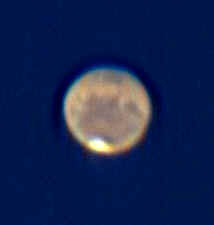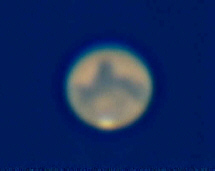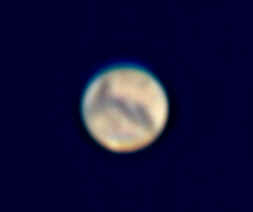 |
 |
 |
|
 |
| |
|
Mars
opposition of 2003 - Webcam images
The past couple of
years have seen a true revolution in planetary
imaging technology with the advent of inexpensive
consumer Webcams, producing stunningly detailed
color portraits of the planets. Although I had been
playing around with the idea of buying a webcam and
giving it a try myself already for several months,
it took me till the middle of this year to finally
make the step. Obviously, the very favourable Mars
opposition in August of this year has been a key
stimulator.
I acquired a Philips
ToUcam Pro, which features a USB interface and a
sensitive 640x480 pixel CCD chip. The device is
capable of taking high-resolution 24-bit color
streaming video. I also bought a 2x Barlow
lens.
 |
I made my
very first Mars video clip in the morning
of August 24, 2003, using the
Philips ToUcam Pro (without Barlow lens)
in combination with the 35-cm SCT
telescope of CBA Belgium Observatory,
working at f/11. The seeing was of medium
quality (Mars really doesn't get very high
above the Belgian horizon these days). To
display and capture my webcam images, I
used the freeware program AVIedit,
which is quite easy to use, yet powerful. |
|
|

|
One can
easily recognize the bright South Polar
cap and the Mare Erythraeum / Sinus
Meridiani regions.
|
|
Mars on August
24, 2003. Equipment used : Celestron C-14 SCT
at f/11 and Philips ToUcam Pro webcam at
640x480 resolution. |
Post-processing of
the Webcam images (including aligning and stacking
of images, selective integration of images
obtained under better seeing) was done using the
freeware program Registax,
which is really a marvellous piece of
high-precision software. The final image was
then refined using Paint Shop Pro's unsharp
masking function.
I realize
that my images are not top notch quality, but for
first trials they don't seem to be too bad. Also,
one should not forget that Mars is not favourably
placed in the Belgian sky, due to its low
altitude.
 | On the morning of August
31, 2003, I made a second attempt to
make webcam images of Mars. The equipment
used was the same as described above, but
this time I used a 2x Barlow to obtain an
even higher focal ratio (f/22 instead of
f/11). The seeing was quite moderate, so
the resulting image is not very sharp.
|
|
|

|
The image
clearly shows that the South Polar cap
has already started to melt (compared to 6
days ago). The dark region in the center of
the image is famous Syrtis Major with
Mare Thyrrenum to the right and Mare
Serpentis to the left. Note also Hellas
to the south of Syrtis Major.
|
|
Mars on August
30, 2003. Equipment used : Celestron C-14 SCT
at f/22 (2x Barlow) and Philips ToUcam Pro
webcam at 640x480 resolution. |
|
|
|
 |
Another
attempt to "webcam" Mars was
made on September 4, 2003
(morning), using the same equipment
(without 2x Barlow lens). The seeing was
quite bad. The resulting image is shown at
right. |
The South
Polar cap has continued to shrink, and
now has almost disappeared. The dark region
towards the left border (East in reality) is
Syrtis Major, followed by Mare
Thyrrenum. Next comes Syrtis Minor with
Mare Cimmerium.
|
|
 |
|
|
Mars on September
4, 2003. Equipment used : Celestron C-14 SCT
at f/11 and Philips ToUcam Pro webcam at
640x480 resolution. |
|
|
|
 |
|
 |
|
|
 |
Copyright © 2003 - Tonny Vanmunster.
|
 |
|
 |